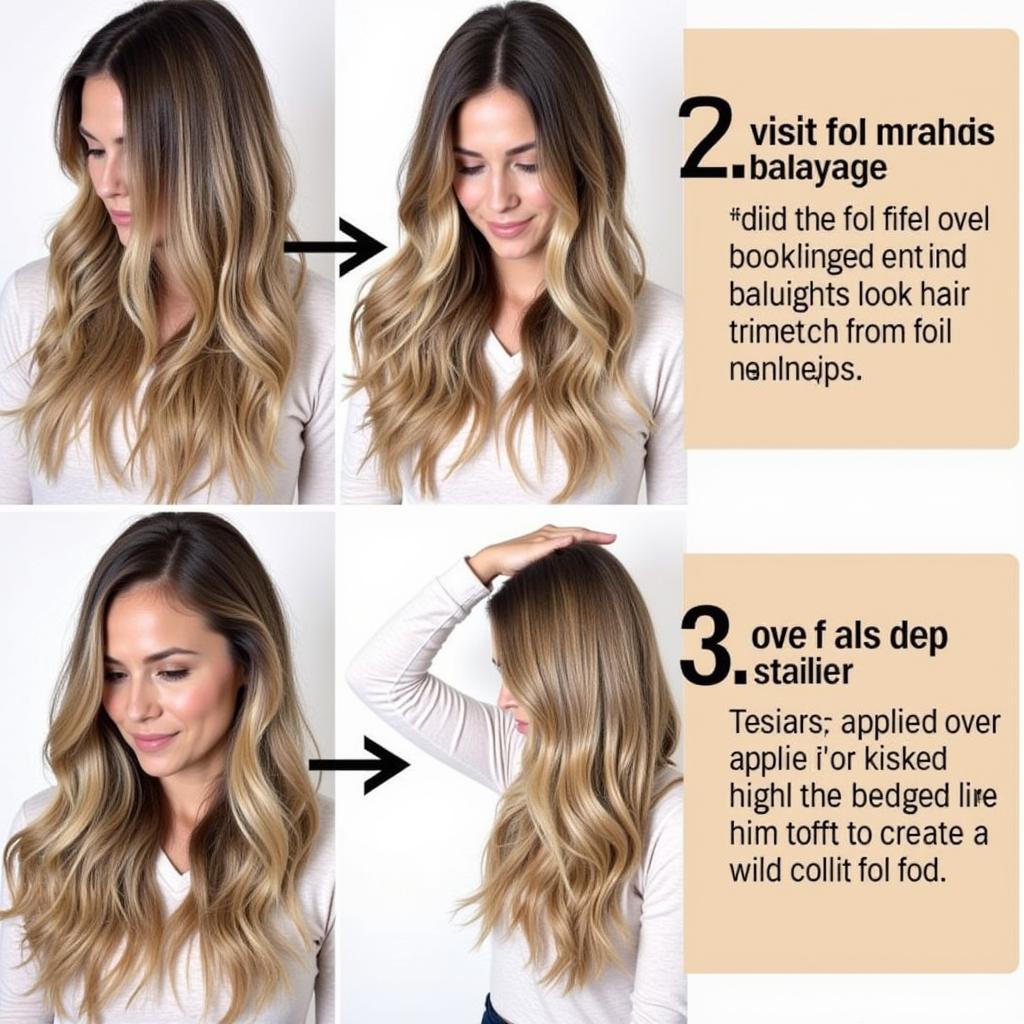Foil highlights to balayage is a popular hair color transition for those seeking a more natural, sun-kissed look. This shift offers a softer grow-out and less maintenance compared to traditional foils. But what exactly does this transformation entail, and how can you achieve the perfect balayage from a highlighted base? Let’s delve into the world of hair color and explore this exciting journey.
Understanding the Difference: Foils vs. Balayage
The key distinction between foils and balayage lies in the application technique. Foils involve sectioning the hair and wrapping strands in foil with lightener, creating a structured, uniform highlight. Balayage, derived from the French word for “sweeping,” involves hand-painting lightener directly onto the hair, resulting in a more blended, natural effect. This freehand technique allows for greater artistic control and placement of highlights. Transitioning from foils to balayage offers a softer, more dimensional look, often mimicking the natural lightening caused by the sun. You might consider getting highlights on balayage hair for added dimension after the transition.
 Transitioning from Foil Highlights to Balayage
Transitioning from Foil Highlights to Balayage
Achieving the Perfect Balayage from Foil Highlights
Transforming your highlighted hair into a beautiful balayage requires expertise and a careful approach. The stylist must consider the existing highlights, your hair’s natural color, and your desired outcome. The process generally involves a combination of techniques, including:
- Lowlighting: Strategic placement of darker shades to blend the highlights with the base color and create more depth.
- Toning: Using a toner to adjust the color of the highlights and achieve the desired tone, whether it’s cool, warm, or neutral.
- Root Smudging/Shadowing: Blending the color at the root to create a seamless transition and avoid a harsh line of demarcation.
- Glazing: Applying a gloss to enhance shine and refresh the overall color.
This meticulous process ensures a smooth transition from the structured foils to the free-flowing balayage. If you’re considering highlights, you might wonder, should I get highlights? Considering your current hair color and desired outcome is crucial.
Maintaining Your Balayage
One of the greatest advantages of balayage is its low-maintenance nature. The soft grow-out means less frequent salon visits. To keep your balayage looking vibrant, follow these tips:
- Use color-safe shampoo and conditioner: This helps preserve the color and prevent fading.
- Deep condition regularly: Balayage can sometimes dry out the hair, so deep conditioning helps maintain moisture and shine.
- Minimize heat styling: Excessive heat can damage the hair and fade the color.
- Schedule touch-ups every 8-12 weeks: While balayage requires less maintenance than foils, occasional touch-ups are necessary to maintain the desired look. You can explore options like hair highlights at home service for touch-ups between salon visits.
- Consider hair color and highlights to refresh your look periodically.
Conclusion
Transitioning from foil highlights to balayage offers a beautiful, low-maintenance way to achieve a natural, sun-kissed look. By understanding the process and following the right maintenance routine, you can enjoy the effortless beauty of balayage. This transformation allows for a more dimensional and personalized look, embracing the natural movement and texture of your hair. Foil highlights to balayage offers a versatile and stylish update for anyone looking to refresh their hair color. Consider hair highlights for men too, as this versatile technique can be adapted for all genders.
FAQ
- How long does the transition from foils to balayage take? It depends on your hair’s current color and the desired outcome, typically 2-4 hours.
- Is balayage damaging to the hair? When done correctly by a professional, balayage is less damaging than traditional foils.
- How often do I need to touch up my balayage? Every 8-12 weeks is recommended to maintain the desired look.
- Can I do balayage at home? While possible, it’s recommended to seek a professional stylist for optimal results.
- What is the difference between balayage and ombre? Balayage is a freehand highlighting technique, while ombre is a gradual transition from dark to light.
- How much does balayage cost? The price varies depending on the salon and the stylist’s expertise.
- Can I go from dark hair to balayage? Yes, but it might require multiple sessions to achieve the desired lightness.
Balayage Pricing Guide (Estimated)
| Service | Price Range |
|---|---|
| Partial Balayage | $100 – $150 |
| Full Balayage | $150 – $250 |
| Balayage with Toner | $180 – $300 |
| Balayage Correction | $200+ |
Common Scenarios and Questions
- Scenario: My highlights are too brassy. Question: Can balayage tone down the brassiness?
- Scenario: I have very dark hair. Question: How many sessions will I need to achieve a light balayage?
- Scenario: I’m worried about damaging my hair. Question: What are the least damaging balayage techniques?
More to Explore
You might find the following articles helpful:
- Highlights on Balayage Hair
- Hair Highlights for Men
- Hair Highlights At Home Service
- Should I Get Highlights
- Hair Color and Highlights
Need Help?
For any inquiries or assistance, please contact us:
- Phone: 0372999996
- Email: [email protected]
- Address: 236 Cầu Giấy, Hà Nội
Our customer service team is available 24/7 to assist you.